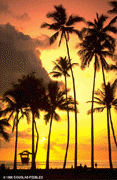

MABUHAY! The warmest of smiles, the friendliest of welcomes. Nothing compares to the Filipino's way of receiving a visitor. When the Spanish conquistadores first set foot on the archipelago in 1521, they were awed not only by the lush panorama that greeted them but also by the way the natives welcomed them and feted their visitors. So taken were they by the people's innate friendliness, the temperate climate, unsullied beaches, spectacular sunsets, luxuriant pastoral lands and bountiful wildlife that they named the emerald string of islands Felipinas, in honor of King Philip II of Spain. Felipinas eventually became known as Philippines or Pilipinas.
Lying in the southeast coast of Asia and surrounded by the Pacific Ocean, the Philippines has a total land area of 300,439 sq. kms. distributed over 7,107 islands - one of the largest island groups in the world - which are grouped into Luzon in the north, Mindanao in the South and Visayas in the middle.
The Philippine archipelago's attractions are as many as they are diverse, with each island offering something different. White sand beaches, lush green forest, majestic mountain peaks, age-old structure, modern cities, rustic countrysides. The list goes on and on.
The country is most popular for its beaches and deep waters teeming with a plethora of marine life. The Philippine waters have attracted a growing number of scuba divers all eager to discover the underwater treasures of the country. Most of the resorts are well-equipped with modern diving equipment and have their staff of professional diving instructors and guides. Those who prefer to keep their feet dry can still view the magical coral world through glass-bottomed boats.
For the nature lover, there is a mountain climbing, birdwatching, cave exploration, and even photo safaris. History and culture buffs may learn more about the Philippines and its people when visiting the museums, centuries-old structures, monuments, and churches spread across the country.
Golfers have also found their place in the sun here in the Philippines. The country boasts of challenging golf courses, some of which were designed by world-class course architects.
Whatever your interests are, our islands have it.
The Filipino is basically of Malay stock, with varying degrees of Chinese, Spanish and American influences. About 60.5 million Filipinos make up the total population.
The Filipino character is actually a little bit of all the cultures put together. The bayanihan or spirit of kinship and camaraderie that Filipinos are famous for is said to be taken from Malay forefathers. The close family relations are said to have been inhereted from the Chinese. The piety comes from the Spaniards who introduced Christianity in the 16th century. Hospitality is common in the Filipino character and this is what distinguishes the Filipinos. Filipinos are probably one of the fiew, if not the only, English-proficient Oriental people today. Pilipino is the official national language, with English considered as the country's unofficial one and used for commercial and legal transactions.
Some 80 percent of the population is Catholic, Spain's lasting legacy. About 15 percent is Moslem and these people can be found basically in Mindanao. The rest of the population is made up mostly of smaller Christian denominations and Buddhists.
 |